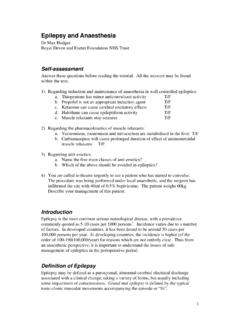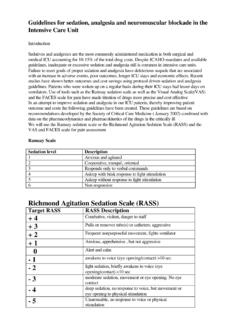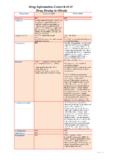Transcription of Pharmacokinetics of midazolam, propofol, and …
1 Pharmacokinetics of midazolam , propofol , and fentanyl transfer to human breast milkBackground and objectives:Lactating women undergoing operations requiring general anesthesia are advisedto pump and discard their milk for 24 hours after the procedure. Data on anesthetic drug transfer into breastmilk are limited. This study determined the Pharmacokinetics of midazolam , propofol , and fentanyl transferinto milk to provide caregivers with data regarding the safety of breast milk after administration of :Five lactating women participated in this study after providing institutionally approved writteninformed consent. Patients underwent premedication with midazolam before induction of anesthesia withpropofol and fentanyl . Anesthesia was maintained with a potent volatile anesthetic. Milk and blood werecollected before drug administration. Milk was collected 5, 7, 9, 11, and 24 hours after drug blood was collected at intervals up to 7 hours.
2 Plasma and milk midazolam , propofol , and fentanylconcentrations were measured by HPLC with tandem mass spectrometric or fluorescence detection. Thepharmacokinetics of drug transfer into milk was modeled with plasma :Plasma midazolam , propofol , and fentanyl Pharmacokinetics were consistent with reports of others. In24 hours of milk collection, averages of (range, ) of the maternal midazolam dose, ( ) of the propofol dose, and ( ) of the fentanyl dose were collected in milk,representing averages of , , and of the respective elimination :The amount of midazolam , propofol , and fentanyl excreted into milk within 24 hours ofinduction of anesthesia provides insufficient justification for interrupting breast-feeding. (Clin PharmacolTher 2006;79:549-57.)Martin Nitsun, MD, Joseph W. Szokol, MD, H. Jacob Saleh, MD,Glenn S. Murphy, MD, Jeffery S. Vender, MD, Lynn Luong, BS, Kiril Raikoff, MS,and Michael J. Avram, PhDEvanston and Chicago, IllDespite the recognized social and medical benefits ofbreast-feeding, the safety of breast milk after the ad-ministration of most drugs remains poorly there are numerous drugs for which carefulrisk assessment is recognized as necessary,1 there areseldom adequate data to provide the basis of a recom-mendation regarding the safety of breast milk aftermaternal drug administration.
3 Too often, safety recom-mendations are made on the basis of theoretical risks,case reports, or case Because dangerousamounts of many drugs are assumed to be transferredinto breast milk, breast-feeding mothers either avoidmedication or do not breast-feed their infants whiletaking medications for fear of harming them throughunnecessary drug exposure, often on the overly cau-tious recommendation of their health De-spite the numerous obstacles to studying drug disposi-tion in breast-feeding women, such studies must beconducted to provide health care providers with data onthe safety of breast milk after drug administration sothey can provide their patients with informed advice onbreast-feeding after drug used commonly for outpatient anesthesia orconscious sedation include benzodiazepines, hypnotics,and opioids. Breast-feeding women must sometimesundergo surgery requiring anesthesia or conscious se-From the Departments of Anesthesiology and Obstetrics and Gyne-cology, Evanston Northwestern Healthcare, Evanston, and Depart-ment of Anesthesiology and Mary Beth Donnelley Clinical Phar-macology Core Facility of Robert H.
4 Lurie Comprehensive CancerCenter of Northwestern University Feinberg School of Medicine, by departmental for publication Oct 3, 2005; accepted Feb 15, requests: Michael J. Avram, PhD, Department of Anesthesi-ology, Northwestern University Feinberg School of Medicine, 303E. Chicago Ave., Ward 13-199, Chicago, IL 2006 by theAmerican Society for Clinical Pharmacologyand with these drugs and want to know when theymay resume breast-feeding safely. Although the trans-fer of diazepam, methohexital, and meperidine intobreast milk has been estimated,4 there are few dataregarding how much of their modern equivalents mi-dazolam, propofol , and fentanyl is transferred to milk,and the information that is available is from studies inthe immediate postpartum period when colostrum isproduced rather than mature milk,5-7 which differs fromcolostrum in both volume and Therefore,physicians err on the side of caution and advise mothersto pump and discard their breast milk for 24 hours afteran operative procedure rather than risk giving theirinfant an unsafe amount of drug by way of their breastmilk.
5 We studied midazolam , propofol , and fentanyltransfer into mature human breast milk to provide sur-gical and anesthesia caregivers with data regarding thesafety of breast milk after administration of these and study lactating womenwith a preoperative hemoglobin level of more than 10g/dL who had scheduled operative procedures necessi-tating general anesthesia participated in this study afterproviding institutionally approved, written informedconsent. Exclusion criteria include patients with Amer-ican Society of Anesthesiologists Physical Status scoregreater than II, gastroesophageal reflux disease, pepticulcer disease, hiatal hernia, body mass index greaterthan 28 kg/m2, and allergies to midazolam , fentanyl , orpropofol. Each patient was instructed not to ingestanything by mouth after midnight the night before theplanned procedure. Intravenous access was establishedfor drug administration. After local anesthesia, a 16- or18-gauge catheter, attached to a stopcock, was placed ina vein to facilitate blood sampling in the arm oppositethat in which intravenous drugs were being adminis-tered.
6 The patient was then brought to the operatingroom where monitors were applied according to theAmerican Society of Anesthesiologists Standards forBasic Intraoperative Monitoring. A standard dose ofmidazolam, 2 mg over 30 seconds, was administeredintravenously to provide preoperative anxiolysis. Thepatient was given oxygen for 5 minutes before induc-tion of anesthesia with standard doses of fentanyl , 100 g over 30 seconds, and propofol , mg/kg over 30seconds. When ease of mask ventilation was confirmed,a standard dose of a neuromuscular blocking agent wasadministered to facilitate tracheal intubation. Anesthe-sia was maintained with an inhaled potent volatileanesthetic agent. At the conclusion of the procedure,neuromuscular blockade was antagonized with stan-dard reversal agents, the trachea was extubated whenusual criteria were met, and the patient was brought tothe postanesthesia care unit. The patient was dischargedto the hospital room from the postanesthesia care unitafter the usual discharge criteria had been milliliters of blood to provide plasma for drugconcentration measurement was withdrawn through thelarge-bore intravenous catheter before drug administra-tion and at 2, 5, 10, 15, 20, 30, 45, 60, 90, 120, 180,300, and 420 minutes after drug administration.
7 Bloodsampling after propofol and fentanyl administrationwas timed to coincide with blood sampling after mida-zolam whenever possible. All samples obtained werecentrifuged, and the plasma was collected and frozenuntil assayed for propofol , midazolam , and were asked to pump breast milk before drugadministration to be used as a blank and to empty thebreasts before operation. All milk produced within 24hours of drug administration was collected from bothbreasts and used solely for purposes of the study, asrecommended for optimal study design9; none wasreturned to the mother for administration to her hours after drug administration and again at 7, 9,11, and 24 hours after drug administration, the patientpumped the breasts with a standard electric breastpump, the most efficacious method of milk The milk expressed from both breasts at eachcollection time was combined into 1 sample, the vol-ume was measured and recorded, and the entire volumewas frozen until assayed for propofol , midazolam , andfentanyl and milk midazolam con-centrations were determined by liquid chromatogra-phy tandem mass spectrometry after sample prepara-tion by solid-phase extraction.
8 In brief, 10 L of g/mL flurazepam dihydrochloride (internal standard)solution and mL of a plasma or milk sample wereadded to a polypropylene tube and acidified bythe addition of 20 L of 85% phosphoric acid. Thesorbent of each well of the Oasis MCX 30 mg Extrac-tion Plate (Waters Chromatography, Milford, Mass)was conditioned with 1 mL methanol and 1 mL water,the prepared sample was applied to the conditionedsorbent, and the sorbent was washed with 1 mL hydrochloric acid and 1 mL methanol. Sam-ples were eluted into a 96-well plate with 500 Lof2%ammonium hydroxide in methanol, dried under vac-uum, and reconstituted with 200 L of mobile phase(described later). Twenty microliters of the reconsti-tuted eluant was analyzed by an API 3000 liquid chro-matography tandem mass spectrometry system (Ap-CLINICAL PHARMACOLOGY & THERAPEUTICS550 Nitsun et alJUNE 2006plied Biosystems, Foster City, Calif) equipped with anAgilent 1100 series HPLC system (Agilent Technolo-gies, Wilmington, Del).
9 Samples were eluted isocrati-cally from a Synergi 4- m Hydro-RP 80A column (50 mm; Phenomenex, Torrance, Calif) with a mo-bile phase consisting of water and methanol ( [vol/vol]) containing formic acid at a flow rate mL/min. The tandem mass spectrometer was op-erated with its electrospray source in the positive ion-ization mode. The mass-to-charge ratios of theprecursor-to-product ion reactions monitored were326 291 for midazolam and 388 315 for fluraz-epam. The retention time of midazolam was min-utes, and that of flurazepam was minutes. Both theplasma and the milk midazolam standard curves werelinear from to ng base/mL with coefficientsof variation of less than throughout the entireconcentration and milk propofol concentrations were de-termined by modification of the method of Plummer,11with liquid chromatography fluorescence spectroscopyas described by Knibbe et al12 after sample preparationby liquid-liquid extraction as described by Ibrahim In brief, 10 L of 150- g/mL thymol (internalstandard) solution, mL of a plasma or milk sample,and mL of sodium hydroxide were added toa conical glass centrifuge tube and the contents weremixed.
10 One and one half milliliters of ethyl acetate/heptane (1:1 [vol/vol]) was added to each tube, and thecontents were mixed thoroughly on a vortex mixer for30 seconds and centrifuged for 3 minutes at was transferred to a polypropylene tube,evaporated to dryness at ambient temperature under astream of nitrogen, and reconstituted with 200 Lofmobile phase. One hundred microliters of the reconsti-tuted eluant was analyzed by an HPLC system consist-ing of a Waters 510 pump (Waters Chromatography), aWaters 717 autosampler (Waters Chromatography),and a Varian 2070 spectrofluorometric detector (Var-ian, Palo Alto, Calif). Samples were eluted isocraticallyfrom a LiChrospher 5- m 100 RP-18 column (125 mm; Merck KGaA, Darmstadt, Germany) with aLiChrospher 5- m(4 4 mm; Merck KGaA) guardcolumn with a mobile phase consisting of acetonitrileand water (60:40 [vol/vol]) containing trifluoro-acetic acid at a flow rate of mL/min. Fluorescencedetection was accomplished with excitation at 276 nmand emission at 310 nm.





